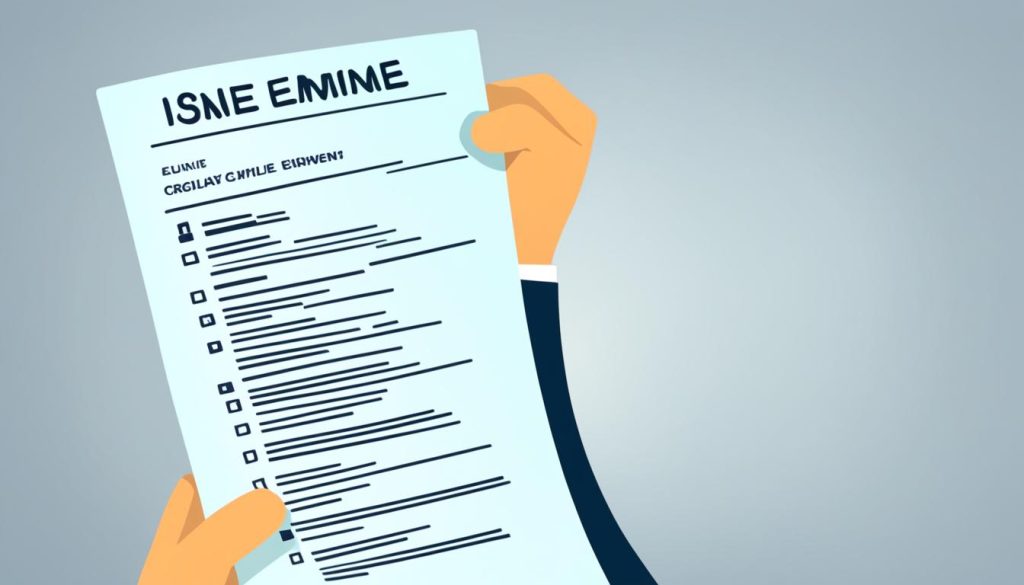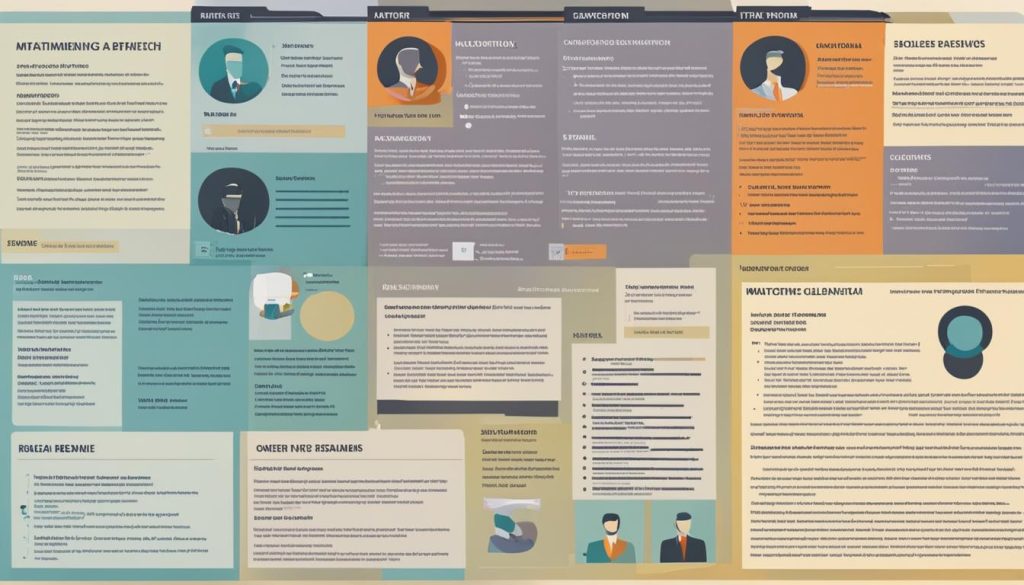Your resume is a crucial tool in the job search process, providing potential employers with a snapshot of your qualifications, skills, and experience. When crafting your resume, one important decision to make is how far back your employment history should go. This timeline is influenced by several factors, including resume length, relevance, and industry standards.
In general, it is recommended to include the most recent 10 to 15 years of job experience on your resume. This ensures that your resume remains concise and focused on your most relevant and recent achievements. However, the optimal timeline can vary depending on the number of years you’ve been in the workforce and the type of role you’re applying for.
It’s crucial to strike a balance between showcasing your experience and keeping your resume concise. Hiring managers often skim through resumes, so it’s essential to highlight your most noteworthy accomplishments within the recommended timeline.
Let’s explore the factors to consider when determining how far back your resume should go and provide some useful guidelines on getting it right.
Key Takeaways:
- Include the most recent 10 to 15 years of experience on your resume.
- Tailor your employment history based on its relevance to the job you’re applying for.
- Consider your years of experience and the type of role you’re seeking.
- Address employment gaps transparently and highlight skills gained during those periods.
- Late-career professionals can have a two-page resume but focus on the most recent 10 to 15 years.
Including Relevant Experience Based on Years of Experience
The amount of job experience plays a crucial role in determining the content of your resume. The number of years you have been in the workforce and the relevancy of each position to the job you are applying for are key factors to consider. Let’s explore how to include relevant experience based on your years of experience:
0-2 Years of Experience
If you are a student or a recent graduate with 0-2 years of experience, it is appropriate to include part-time jobs, internships, and extracurricular activities that demonstrate transferable skills. These experiences showcase your dedication, teamwork, and ability to handle responsibilities. Highlight any achievements or leadership roles during this time to make your resume stand out.
3-5 Years of Experience
As you gain more experience in your field, it becomes more important to focus on recent and relevant work experiences. You can start by highlighting your most recent and impactful roles. Emphasize the skills and accomplishments that best align with the job you are seeking. This helps the employer understand your expertise and the value you can bring to their organization.
6+ Years of Experience
For individuals with 6 or more years of experience, it’s essential to showcase your professional growth and expertise. Focus on your most recent and relevant positions, highlighting accomplishments that demonstrate your leadership, problem-solving abilities, and industry knowledge. Consolidate older experiences or include them in a separate section to keep your resume concise and focused.
Regardless of your years of experience, always prioritize the content that is most relevant to the job you are applying for. Tailor your resume to highlight the skills, achievements, and experiences that align with the specific job requirements. This approach demonstrates your understanding of the employer’s needs and increases your chances of securing an interview.
| Years of Experience | Resume Content | Resume Sections |
|---|---|---|
| 0-2 Years | Include part-time jobs, internships, and extracurricular activities | Education, Experience, Skills |
| 3-5 Years | Highlight recent and relevant work experiences | Experience, Skills, Achievements |
| 6+ Years | Focus on recent and impactful roles, showcase professional growth | Experience, Skills, Leadership, Certifications |
Remember, your resume is a reflection of your professional journey. By including the most relevant experiences and aligning them with the job you are applying for, you can create a compelling resume that captures the attention of potential employers and highlights your suitability for the role.
Handling Employment Gaps on Your Resume
If you have experienced employment gaps in your work history, it’s crucial to address them effectively on your resume. This section will provide you with some strategies to explain these gaps and present your skills and experiences in the best possible light.
One approach to addressing employment gaps is to include an objective statement at the top of your resume. The objective statement should briefly explain the reason for the gap and highlight your motivation and readiness to re-enter the workforce. This allows employers to understand the context behind the gap and shows them that you are actively seeking employment.
Alternatively, you can incorporate a line in your chronological work history that accounts for the time off. For example, if you took a break to travel or care for a family member, you can mention this briefly in parentheses next to the corresponding job entry. This acknowledges the gap without dwelling on it and shifts the focus back to your professional experiences and achievements.
Quote:
“Addressing any employment gaps on your resume is essential, as it demonstrates your ability to adapt and overcome challenges. By proactively explaining the gaps, you can reassure employers and emphasize the valuable skills you gained during those periods, such as volunteer work, freelance projects, or learning new skills.”
Another effective method for handling employment gaps is to highlight the skills and accomplishments you acquired during that time. If you pursued additional education, completed certifications, engaged in volunteer work, or embarked on freelance projects during your gap, emphasize these experiences in a separate section or within your work history. This demonstrates your ongoing commitment to personal and professional development.
Remember, honesty and transparency are key when addressing employment gaps. It is important to provide a concise and truthful explanation while focusing on the positive aspects of your gap period. By effectively presenting your skills and experiences, you can reassure employers of your capability and showcase your dedication to professional growth.
Strategies for Addressing Employment Gaps
| Strategy | Description |
|---|---|
| Objective Statement | Include a brief statement at the top of your resume to explain the gap and highlight your readiness to re-enter the workforce. |
| Chronological History | Add a line next to the corresponding job entry that accounts for the gap, mentioning the reason briefly in parentheses. |
| Highlight Skills and Accomplishments | Emphasize the skills and accomplishments gained during the employment gap, showcasing ongoing personal and professional development. |
By utilizing these strategies, you can effectively address employment gaps on your resume and present a well-rounded professional profile to potential employers.
Resume Length for Late-Career Professionals

As a late-career professional with over 15 years of experience, I understand the importance of crafting a resume that effectively showcases my skills and qualifications. One common question that arises is how long my resume should be. Is a two-page resume too lengthy? Should I include my entire work history or only recent experience? Let’s explore these questions and find the best approach for late-career professionals like myself.
When it comes to resume length, it is generally acceptable for late-career professionals to have a two-page resume. This allows for ample space to include relevant details about your extensive work experience and achievements. However, it’s crucial to strike a balance between providing enough information and keeping your resume focused on the most recent and impactful roles.
Instead of including your entire work history, it is recommended to concentrate on the last 10 to 15 years of relevant experience. This approach not only keeps your resume concise but also avoids age discrimination concerns. By highlighting your recent accomplishments, you demonstrate your current expertise and stay up-to-date with industry trends.
If you have exceptional achievements or notable experiences from earlier in your career that are still relevant and impressive, you may consider adding a separate section titled “Early Work History.” This section allows you to highlight key highlights such as awards, major accomplishments, or significant projects. Including these highlights can provide additional context and showcase your long-standing commitment to excellence.
Remember, the focus of your resume should always be on aligning your skills, qualifications, and accomplishments with the job you are applying for. By tailoring your resume to the specific role and emphasizing your most recent and relevant experiences, you increase your chances of standing out as a late-career professional.
Tips for Late-Career Professionals:
- Focus on the last 10 to 15 years of relevant work experience
- Highlight recent accomplishments and skills that align with the job you are applying for
- Consider adding a separate section for early career highlights
- Keep your resume concise and avoid including irrelevant or outdated information
- Tailor your resume to the specific job description and industry
What to Include in Your Resume

When crafting your resume, it’s crucial to carefully consider the content you include. The specific sections and details you incorporate will depend on various factors such as your career stage, industry, and the job you are applying for. To create a standout resume that catches the attention of employers, follow these essential tips:
1. Customize Your Resume
Every job is unique, and your resume should reflect that. Tailor your resume to match the specific job description and requirements. Analyze the job posting and identify keywords, skills, and experiences that the employer is seeking. Then, incorporate these elements into your resume to showcase how well you fit the position.
2. Highlight Relevant Experiences and Skills
Focus on presenting the most valuable and relevant experiences in your resume. Highlight your achievements and accomplishments that demonstrate your ability to excel in the desired role. Showcase your skills and expertise that align with the job description, making it clear why you are the best candidate for the position.
3. Structure Your Resume
Organize your resume into clear sections to enhance readability. Common resume sections include:
- Contact Information
- Summary/Objective Statement
- Professional Experience
- Education and Certifications
- Skills
- Awards and Achievements
- References
Make sure each section is relevant and impactful, providing valuable information to potential employers.
4. Choose the Right Resume Format
There are various resume formats to choose from, such as chronological, functional, and combination formats. Consider your career history and the job you are targeting when deciding on the format. A chronological resume focuses on your work history, while a functional resume highlights your skills and abilities. A combination format combines elements of both. Select the format that best showcases your qualifications and aligns with the job requirements.
5. Customize the Job Description
Your resume should speak directly to the job description. Use similar language and keywords found in the job posting to demonstrate your understanding of the role and industry. This customization shows that you have carefully read the job description and are genuinely interested in the position.
By considering these factors and following these tips, you can create a compelling and effective resume that stands out from the competition. Remember to continually update your resume and tailor it to each job application to maximize your chances of success.
Conclusion
In conclusion, when determining how far back your resume should go, it is crucial to consider your years of experience and the relevance of each position to the job you are applying for. As a general guideline, including the most recent 10 to 15 years of work experience is recommended. However, it is essential to customize your resume to align with the specific job requirements, tailoring the content to showcase your most valuable and relevant experiences.
To create an effective resume, it is important to highlight your qualifications and increase your chances of landing the desired job. By following these resume tips and guidelines, you can craft a resume that captures the attention of potential employers and clearly demonstrates your expertise and capabilities.
FAQ
How far back should your resume go?
It is generally recommended to include the most recent 10 to 15 years of job experience on your resume.
What should I include in my resume based on my years of experience?
For students or recent graduates with 0-2 years of experience, include part-time jobs, internships, and extracurricular activities that demonstrate transferable skills. As you progress in your career, focus on recent and relevant work experiences.
How do I address employment gaps on my resume?
You can use an objective statement, include a line in your chronological history, or highlight skills and accomplishments during the gap period.
How long should a late-career professional’s resume be?
It is acceptable to have a two-page resume, but include only the most recent 10 to 15 years of work experience.
What should I include in my resume?
Customize your resume to match the job description and highlight the skills and experiences that make you the best candidate.

